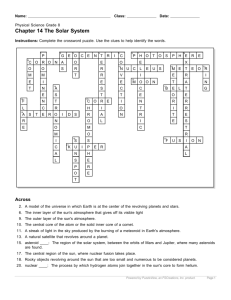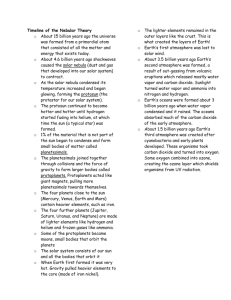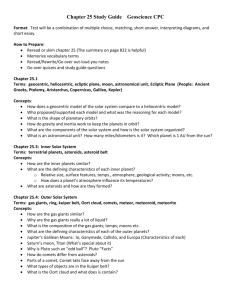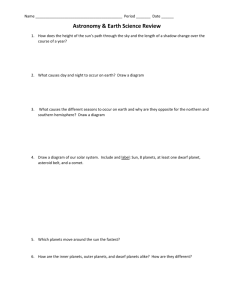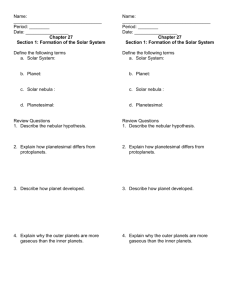NAME: PERIOD: ______ SOLAR SYSTEM The Inner Planets Study
advertisement
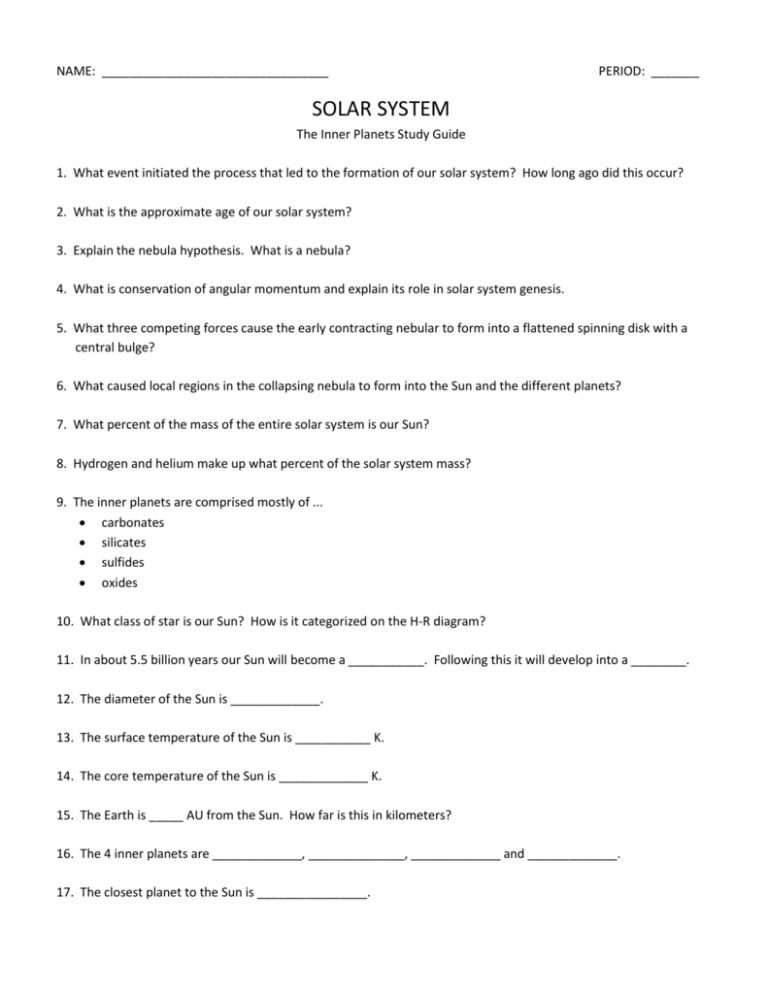
NAME: _________________________________ PERIOD: _______ SOLAR SYSTEM The Inner Planets Study Guide 1. What event initiated the process that led to the formation of our solar system? How long ago did this occur? 2. What is the approximate age of our solar system? 3. Explain the nebula hypothesis. What is a nebula? 4. What is conservation of angular momentum and explain its role in solar system genesis. 5. What three competing forces cause the early contracting nebular to form into a flattened spinning disk with a central bulge? 6. What caused local regions in the collapsing nebula to form into the Sun and the different planets? 7. What percent of the mass of the entire solar system is our Sun? 8. Hydrogen and helium make up what percent of the solar system mass? 9. The inner planets are comprised mostly of ... carbonates silicates sulfides oxides 10. What class of star is our Sun? How is it categorized on the H-R diagram? 11. In about 5.5 billion years our Sun will become a ___________. Following this it will develop into a ________. 12. The diameter of the Sun is _____________. 13. The surface temperature of the Sun is ___________ K. 14. The core temperature of the Sun is _____________ K. 15. The Earth is _____ AU from the Sun. How far is this in kilometers? 16. The 4 inner planets are _____________, ______________, _____________ and _____________. 17. The closest planet to the Sun is ________________. 18. Which of the terrestrial planets ... is the largest? ________________ is the smallest? __________________ is the hottest? ________________ has the greatest temperature range? __________________ has a retrograde rotation? _________________ has a runaway greenhouse effect occurring in its atmosphere? __________________ has no atmosphere? _________________ aside from the Earth generates a magnetic field? __________________ has liquid water? ________________ has rotational and revolutional periods most similar to the Earth? _______________ is 1 AU from the Sun? _________________ is 1.52 AU from the Sun? _________________ is .38 AU from the Sun? __________________ is .72 AU from the Sun? _________________ lie within the habitable zone? _________________ has captured asteroids as moons? _______________ has no moons? _________________ has the greatest atmospheric pressure? ________________ is tectonically active? _________________ has largest volcano in the solar system? ________________ has the largest canyon in the solar system? ________________ is mostly CO2 ? ________________ aside from the Earth could harbor life? _______________ has a geologic history most similar to the Earth? _________________ has a moon formed from a collision with a Mars size planetismal? ________________ has a core composition of iron and sulfur? ________________ has a core composition of iron and nickel? ________________ has seasonal dust storms? _______________ has abundant and diverse life forms? ________________ has an atmosphere divided into 5 layers? ________________ has a tilted magnetic field? _______________ is heavily cratered? ______________ has the weakest gravitational field? _______________ has the strongest gravitational field? _______________ is the most massive? _______________ is the least massive? _______________ has no volcanoes (active or extinct)? ______________ has the longest days? ______________ has the shortest days? ______________ has an atmosphere of mostly nitrogen? ______________ has 15 major tectonic plates? _______________ has the most moons? ________________ PLANET and Symbol Mercury Venus Earth Mars Distance from Sun AU Diameter km Period of Rotation Period of Revolution Temperature C External Structure and Composition Internal Structure and Composition
